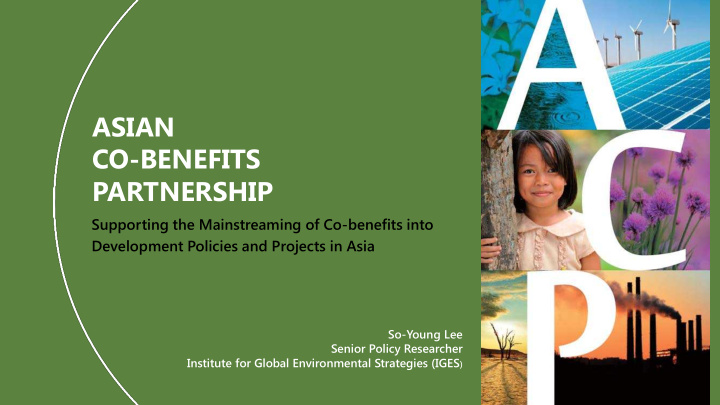



ASIAN CO-BENEFITS PARTNERSHIP Supporting the Mainstreaming of Co-benefits into Development Policies and Projects in Asia So-Young Lee Senior Policy Researcher Institute for Global Environmental Strategies (IGES )
1 Methodology Illustrating Co-benefits Win-win strategy capturing both development and climate benefits in a single policy/measure Asian Co-benefits Partnership Launched in 2010 (Secretariat: IGES) to enable a variety stakeholders to work together on co-benefits • to support the mainstreaming of co-benefits into decision- • making processes in Asia Major Functions of ACP Information sharing and knowledge management • Enhanced communication among ACP members • Support for co-benefits policies and projects in Asia • www.cobenefit.org Strengthening of regional cooperation to promote co-benefits • 2 2
ACP Good Practice Map 1 More and more countries in Asia are introducing projects that mitigate climate changes while achieving other sustainable development benefits. The co-benefits map provides users with important information on co-benefits in key sectors in Asia. 3 3
1 “Highlights the co-benefits of integrated ACP White Paper approaches to air pollution and climate change. ” ____________ in the 1 st White Paper 2014 The White Paper is published every other year to share the latest policy-relevant insights on co-benefits in Asia. “Case studies shed light on the growing number of activities that could achieve climate and other development objectives in Asia. ” ___________________ in the 2 nd White Paper 2016 “Introduces the tools and methods that can help quantify co-benefits in Asia. ” ___________ in the 3 rd White Paper 2018 4 4
ACP White Paper II: Putting Co-benefits into Practice 2 Challenges Summary of challenges and solutions Location Challenges Solutions Waste Japan Limited long-term budget Market expansion for recyclables and stable procurement practices Illegal dumping of chargeable waste Promoting of waste separation and green purchasing Strengthening extended producer responsibility laws Bangladesh Lack of public awareness Raising international capital for waste disposal site improvements Limited financial standing and institutional Re-engineering landfills to realize climate and other co-benefits capacity Indonesia Lack of methane capture regulation Strengthen capacities to improve regulatory compliance High initial investment costs Expanding the market for palm oil Transport Philippines Lack of protected infrastructure for safe cycling Strengthening of PPPs Limited financial/institutional capacity Promoting multi-organizational mobility planning Lack of robust data and data gathering protocols Harmonizing data collection protocols Thailand Lack of financial planning and technical skills Aligning existing policies with NAMA Resistance from groups affected by NAMA Long-term engagement and capacity building Energy Mongolia Lack of operator capacity Institutional capacity building program Lack of financial incentives Improved data availability/accessibility China Lack of sufficient financing Acquiring carbon finance Frequent leadership changes Multi-year capacity building program India Lack of data Improved data collection and monitoring practices Continues awareness raising 5 5
Recommendations Capacity building of co-benefits needs to be sustained and fit-for-purpose. • 2 Public finance can help start a co-benefits project; the private sector is critical for • making a project financially viable in the medium to long-term. Policymakers need to steadily improve co-benefits data collection and monitoring • processes. Governments should seek local expertise and international collaboration when gathering, analyzing, and sharing co-benefits data. Institutional reforms across multiple levels and sectors are critical for maximizing the • 3 co-benefits of innovative solutions. Continued public awareness raising can improve the performance of a project or • policy. 6 6
Institutional 3 Arrangement ADB TA7914 project employed a multi-level approach: Institutional capacity building for climate and gender agencies enabled the mainstreaming of gender into mitigation policies (or vice versa) that supported gender-responsive mitigation pilot projects. These different elements were mutually reinforcing. PARTICIPATORY The pilot projects involved women in concrete on-the-ground initiatives that built knowledge and skills to mitigate climate change while earning other livelihood benefits. Simultaneously, the institutional capacity building and policy mainstreaming empowered women and women’s groups, engaging them in decisions that could help achieve longer-lasting results. 7 7
Long-term 4 Impacts Current Trend on International Climate Policy 1) Scope of climate mitigation is increasing – from projects to policies to institution 2) Direction of climate mitigation is changing – from top down to bottom up 2015 Paris Agreement Ratcheting up ambition for NDCs requires integration at multiple levels 3) Emphasis on sustainability and inclusivity is growing – need more systematic ways to ensure that climate mitigation actions are consistent with other environmental priorities and socioeconomic needs. 2030 Agenda for Sustainable Development All of these changes underline the importance of working with multiple stakeholders at multiple levels for multi benefits. 8 8
Recommend
More recommend